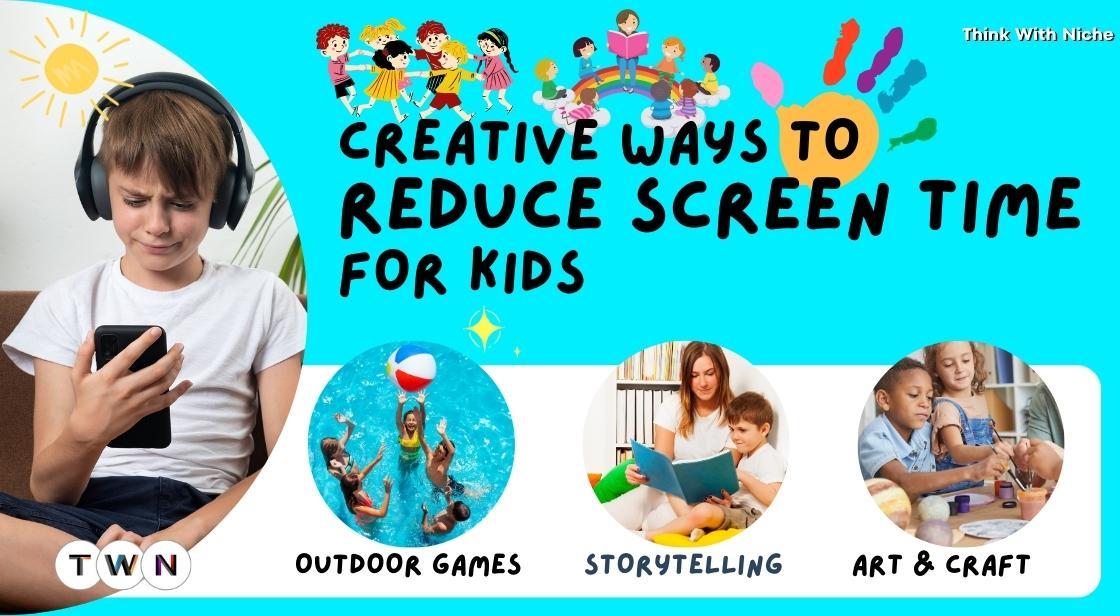Creative Ways to Reduce Screen Time and Keep Kids Busy

Blog Post
In today's digital age, children are increasingly exposed to screens, whether it's television, computers, tablets, or smartphones. While technology can be a valuable tool for learning and entertainment, too much screen time can have negative consequences for children's development.
Excessive screen time can lead to sleep problems, attention difficulties, and even addiction. Therefore, it's important to find creative ways to reduce screen time and keep kids busy.
Recent studies shed light on the concerning effects of excessive screen time on children's health and development. According to the American Academy of Pediatrics, children aged 2 to 5 years who spend more than an hour a day on screens are more likely to exhibit behavioral and attention problems.
Additionally, prolonged screen exposure is associated with decreased physical activity levels, contributing to increased obesity rates among children. The blue light emitted by screens can also disrupt sleep patterns, leading to sleep deprivation, impacting mood, cognitive function, and overall well-being.
With these adverse effects increasingly documented by researchers and healthcare professionals, it's imperative to explore alternative activities and strategies to reduce children's screen time while promoting healthy development.
In today's digital age, children are increasingly exposed to screens, whether it's television, computers, tablets, or smartphones. While technology can be a valuable tool for learning and entertainment, too much screen time can have negative consequences for children's development.
Excessive screen time can lead to sleep problems, attention difficulties, and even addiction. Therefore, it's important to find creative ways to reduce screen time and keep kids busy.
In today's world, it's hard to keep kids away from screens. Technology is everywhere, and it's often the easiest way to keep kids entertained. However, too much screen time can have negative consequences for kids' development.
According to the American Academy of Pediatrics, children under 18 months should avoid screen time altogether, and children ages 18-24 months should have no more than one hour of high-quality screen time per day. For children ages 2-5 years, the AAP recommends limiting screen time to one hour per day, and for children over 5 years old, the AAP recommends limiting screen time to two hours per day.
Negative effects of excessive Screen Time for Kids
Excessive screen time has become a prevalent concern among parents and healthcare professionals as children increasingly engage with various electronic devices, including smartphones, tablets, televisions, and computers. While technology offers a wealth of educational and entertainment opportunities, prolonged exposure to screens can have detrimental effects on a child's physical, mental, and social development.
Physical Health Concerns
Excessive screen time can lead to a sedentary lifestyle, which contributes to obesity, heart disease, and other chronic health conditions. A study published in the journal "Pediatrics" found that children who spend more than two hours per day watching television are more likely to be overweight or obese.
Sleep Disturbances
The blue light emitted from screens can disrupt melatonin production, a hormone that regulates sleep patterns. This can lead to sleep problems, such as difficulty falling asleep, waking up during the night, and feeling tired during the day. A study published in the journal "Sleep" found that children who use electronic devices before bed have a higher risk of sleep problems.
Attention Difficulties
Excessive screen time can also lead to attention difficulties, such as hyperactivity and inattention. A study published in the journal "Clinical Pediatrics" found that children who use electronic devices for more than two hours per day are more likely to have attention problems.
Emotional and Social Development
Excessive screen time can interfere with children's emotional and social development. Children who spend too much time in front of screens may have difficulty developing empathy, social skills, and emotional regulation. A study published in the journal "Child Development" found that children who spend more than two hours per day watching television are more likely to have behavioral problems.
Language Development
Excessive screen time can also delay language development. Children who spend too much time watching television or using electronic devices may have difficulty learning new words and forming sentences. A study published in the journal "Pediatrics" found that children who spend more than two hours per day watching television are more likely to have language delays.
Mental and Emotional Well-being
Screen time can negatively impact children's sleep patterns, leading to sleep deprivation, irritability, and difficulty concentrating. A study published in the Journal of Pediatrics found that children who used electronic devices for more than an hour before bedtime had poorer sleep quality and were more likely to experience attention problems.
Excessive screen time can also contribute to anxiety, depression, and social isolation. A study by the University of California, San Diego, found that adolescents who spent more than two hours per day on social media were twice as likely to report symptoms of depression and anxiety.
Recommendations for Limiting Screen Time
The American Academy of Pediatrics (AAP) recommends that children under 18 months should avoid screen time altogether, and children ages 18-24 months should have no more than one hour of high-quality screen time per day. For children ages 2-5 years, the AAP recommends limiting screen time to one hour per day, and for children over 5 years old, the AAP recommends limiting screen time to two hours per day.
Examples of Studies from Around the World
-
Canada: A study published in the journal Pediatrics found that Canadian children who spent more than two hours per day on screens were more likely to report symptoms of depression and anxiety.
-
China: A study by the Chinese University of Hong Kong found that Chinese children who spent more than two hours per day on screens were more likely to experience sleep problems and attention difficulties.
-
United Kingdom: A study by the University of Oxford found that UK children who spent more than two hours per day on screens were more likely to experience obesity and have lower levels of physical activity.
-
United States: A study by the Centers for Disease Control and Prevention (CDC) found that US children who spent more than two hours per day on screens were more likely to have poorer academic performance and be more likely to engage in risky behaviors.
-
India: A study published in the Indian Journal of Pediatrics found that Indian children who spent more than two hours per day on screens were more likely to experience sleep disturbances, attention problems, and obesity. A study by the Public Health Foundation of India found that Indian children who spent more than two hours per day on screens were more likely to have lower levels of physical activity and higher levels of stress.
These studies provide compelling evidence that excessive screen time can have a range of negative effects on children's physical, mental, and social development. Parents and healthcare providers should encourage children to engage in a variety of activities, including physical activity, social interaction, and creative play, to promote healthy development.
Also Read : World Mental Health Day 2023: Teenagers and the Impact of Screen Time
Strategies for Reducing Screen Time
Creative Ways to Reduce Screen Time and Keep Kids Busy
Get Kids Active
One of the best ways to reduce screen time is to get kids active. Physical activity is essential for kids' physical and mental health. It helps them to develop strong muscles and bones, improves their coordination and balance, and boosts their mood. There are many different ways to get kids active, such as playing outdoors, going for walks or bike rides, or playing sports.
Encourage Hands-on Activities
Hands-on activities are a great way to help kids develop their creativity and problem-solving skills. There are many different types of hands-on activities, such as painting, drawing, building with blocks, or playing with puzzles.
Make Reading a Priority
Reading is a great way to help kids develop their language skills and imagination. Encourage kids to read books, magazines, or comics. You can also make reading fun by reading aloud to them or taking them to the library.
Set Limits on Screen Time
It's important to set limits on screen time and enforce them consistently. Talk to your kids about the importance of limiting screen time and explain why it's important. You can also create a schedule for screen time and stick to it.
Be a Good Role Model
Kids are more likely to follow your example than your rules. So, be a good role model and limit your own screen time. When you're spending time with your kids, put your phone away and focus on interacting with them.
Screen-free activities for toddlers
-
Sensory Play: Engage their senses with activities like finger painting, exploring a sensory bin filled with various textures, playing with water or sand, or creating homemade playdough.
-
Building and Construction: Encourage creativity and problem-solving skills with blocks, wooden planks, puzzles, or magnetic tiles.
-
Pretend Play: Provide props and costumes for imaginative play, such as toy kitchens, play food, cars, dolls, or dress-up clothes.
-
Arts and Crafts: Foster creativity and fine motor skills with activities like coloring, drawing, painting, tearing and gluing paper, or making homemade crafts.
-
Musical Play: Introduce music with instruments like toy drums, xylophones, shakers, or simply sing and dance together.
-
Movement and Exercise: Encourage physical activity with indoor or outdoor games like ball games, dancing, obstacle courses, or yoga for kids.
-
Books and Storytelling: Nurture language development and a love for reading with storytelling sessions, engaging picture books, and interactive songs or fingerplays.
-
Nature Exploration: Take trips to the park, playground, or backyard to explore nature, collect leaves or rocks, watch insects, or plant flowers.
-
Cooking and Baking: Involve toddlers in simple cooking tasks like stirring ingredients, helping to set the table, or decorating cookies.
-
Water Play: Engage their senses with water play activities like filling a tub with water, splashing toys, or playing with a sprinkler or hose.
-
Creative Movement: Encourage them to express themselves through movement by dancing, imitating animals, or following along with simple yoga poses.
-
Puzzles and Brain Games: Stimulate their minds with simple puzzles, memory games, or matching activities.
-
Interactive Games: Engage in interactive games like hide-and-seek, Simon Says, or animal charades.
-
Singing and Song Play: Sing with them, make up new songs together, or use rhythm instruments to accompany familiar tunes.
-
Storytelling and Make-believe: Engage in imaginative storytelling sessions, creating characters and scenarios together.
-
Arts and Crafts with Recycled Materials: Turn everyday items into creative projects, like making puppets from socks, collages from magazines, or sculptures from cardboard boxes.
-
Outdoor Exploration: Go on nature walks, explore local parks, or visit a petting zoo to discover the natural world.
-
Sensory Explorations: Create sensory bins filled with different textures, smells, and sounds to engage their senses.
-
Dramatic Play with Imaginary Friends: Encourage imaginative play with props like puppets, dolls, or stuffed animals.
-
Building and Construction with Blocks and Duplos: Let them explore different shapes, sizes, and colors while building towers, bridges, or cars.
Screen-free activities for 2-5-year-olds
Sensory Play:
-
Sensory Bin: Create a sensory bin filled with various textures, such as dry beans, rice, pasta, or water beads.
-
Playdough Fun: Make your own playdough using natural ingredients and explore different colors and scents.
-
Water Play: Splash and play in a tub of water, add toys and containers for extra fun.
-
Finger Painting: Engage in messy but creative finger painting using washable paints and paper.
-
Texture Collage: Collect different textured materials and create a collage on a piece of cardboard or paper.
Building and Construction:
-
Block Building: Provide a variety of building blocks, including wooden blocks, Duplos, or Legos, and let their creativity run wild.
-
Fort Building: Gather blankets, sheets, and pillows to construct a cozy fort or playhouse.
-
Magnet Tile Creations: Explore the endless possibilities of magnetic tiles, building walls, shapes, and structures.
-
Cardboard Creations: Transform cardboard boxes into rockets, cars, or playhouses with imagination and a bit of tape.
-
Construction Playsets: Engage in role-playing and construction with toy trucks, cranes, excavators, and construction workers.
Pretend Play:
-
Play Kitchen: Set up a play kitchen with toy appliances, play food, and utensils for imaginative cooking and baking.
-
Provide a dollhouse or doll furniture and let them create scenarios and stories with their dolls.
-
Dress-up Fun: Fill a dress-up bin with various clothing items, hats, accessories, and props for role-playing.
-
Doctor or Veterinarian Play: Engage in pretend play using a doctor's kit or pretend animal care supplies.
-
Superhero Adventures: Encourage imaginative play with capes, masks, and props, creating their own superhero personas.
Arts and Crafts:
-
Finger Painting and Coloring: Provide plenty of paper, washable paints, crayons, and markers for creative expression.
-
Painting with Nature: Use leaves, flowers, or fruit stamps to create unique nature-inspired art.
-
Tearing and Gluing Paper: Tear colored paper into pieces and glue them onto a background to create collages.
-
Homemade Crafts: Make crafts using recyclable materials like toilet paper rolls, cardboard boxes, or egg cartons.
-
Playdough Sculptures: Sculpt shapes, animals, or figures using colorful playdough.
Musical Play:
-
Instrument Exploration: Provide toy instruments like drums, xylophones, shakers, or simply sing and dance together.
-
Music and Movement Games: Engage in musical games like freeze dance, follow the leader, or Simon Says with music.
-
Musical Storytelling: Create stories using sound effects, instruments, and singing to enhance the narrative.
-
Homemade Instruments: Create homemade instruments using recyclable materials and explore different sounds.
-
Dance Party: Put on some music and have a dance party, encouraging them to move freely and express themselves.
Movement and Exercise:
-
Indoor Obstacle Course: Create an indoor obstacle course using pillows, chairs, blankets, and other household items.
-
Outdoor Adventures: Go for walks, play at the park, or explore local trails to promote physical activity.
-
Yoga for Kids: Engage in simple yoga poses and exercises designed for children.
-
Animal Movement Games: Imitate animal movements like crawling like a crab, hopping like a rabbit, or flying like a bird.
-
Ball Games: Play catch, throw and roll balls, or engage in fun ball games like bowling or soccer.
Books and Storytelling:
-
Read-Aloud Sessions: Read engaging picture books, stories, and poems with plenty of expression and sound effects.
-
Interactive Storytelling: Make up stories together, taking turns adding to the narrative.
-
Storytelling with Puppets: Use puppets or stuffed animals to act out stories, fostering language development and imagination.
-
Song Play and Fingerplays: Engage in interactive song play and fingerplays to enhance language skills and creativity.
-
Create Your Own Storybook: Draw and write stories together, creating a personalized storybook.
Nature Exploration:
-
Nature Walks: Take walks in parks, forests, or nature trails, observing plants, animals, and natural surroundings.
-
Leaf and Rock Collection: Collect interesting leaves, rocks, or shells and create a nature collection.
-
Gardening Play: Involve in planting seeds, watering plants, and observing the growth cycle.
Here are some additional tips for reducing screen time and keeping kids busy:
-
Create a screen-free zone in your home, such as the bedroom or the dinner table.
-
Have regular family activities that don't involve screens, such as game nights or movie nights.
-
Encourage kids to develop hobbies and interests that don't involve screens, such as sports, music, or art.
-
Talk to your kids about the dangers of addiction and overuse of technology.
By following these tips, you can help your kids reduce their screen time and develop healthy habits. Remember, it's important to be patient and consistent. It takes time for kids to adjust to new rules and routines. But with your help, they can learn to limit their screen time and enjoy other activities.
You May Like
EDITOR’S CHOICE












